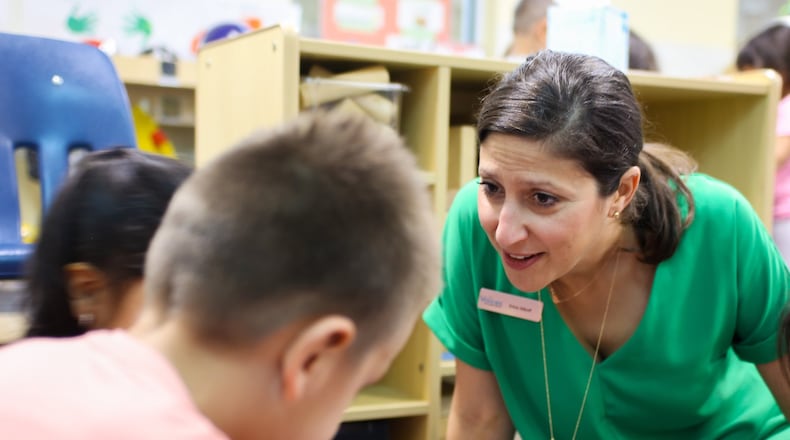These are sad times for our kids.
All across the state, they are harming themselves in numbers unseen before, and it’s getting worse every day.
According to Dr. Erica Fener Sitkoff, a clinical psychologist who for the past three years has been heading Voices for Georgia’s Children, 58,583 kids in sixth to 12th grades considered suicide in 2017. That figure jumped to 78,969 in 2018 then dipped slightly to 77,878 in 2019. During that same time period, 39,226 kids attempted suicide last year, compared to 37,508 in 2018 and 25,758 in 2017.
“There are instances of attempts and completed suicides in Georgia over the past two years with children as young as 9 and 10 years old,” Sitkoff said. “If you think about these numbers and the prevalence they represent, you know that every community is touched by this, and that we need to start thinking about this sooner, before they get to middle school and definitely before they get to high school.”
I’ve been writing about these numbers so much I’m starting to sound like a stuck record even to myself. But the numbers tell me no story about our children’s mental health is one too many.
As Georgia leaders began setting budget priorities for the coming fiscal year, Voices for Georgia’s Children, a statewide, nonprofit child policy and advocacy organization, seized on the moment to bring awareness to what seems to me is a shameful blight on our children.
Suicide is the second-leading cause of death behind unintentional injury for children ages 10-17 in Georgia, Sitkoff said. Not illness. Suicide.
In 2018, 63 children ages 10-17 in Georgia committed suicide.
In addition, 75% of children involved in the juvenile justice system have experienced traumatic victimization, she said.
That won’t sit well with those who want to lock young offenders up and throw away the keys, but there it is. And one other thing: When surveyed, nearly 62,000 sixth through 12th graders in Georgia report that they harmed themselves on purpose last year.
There’s no other way to say this except that’s terrible. Terrible. Terrible.
It’s the kind of thing that keeps Sitkoff up at night because she knows perhaps better than anyone, these aren’t just numbers. These are flesh-and-blood children.
RELATED | Another suicide, another parent’s drive to prevent more
Sitkoff remembered one girl in particular, a high schooler who’d been through so much before she attempted suicide.
“In all her life experiences, no one ever told her that she mattered,” Sitkoff said. “No one ever told her that she had value.”
Luckily, that teen, she said, is in a more hopeful place, convinced that if she could for the rest of her life just be able to tell other little girls how much they matter so no one else has to grow up thinking that no one cares for them, then it would all be worth it to her.
I asked Sitkoff what might be fueling such hopelessness, and she said it’s not just one thing.
First, she said, we’re better at asking the questions and getting the information. Youths have probably been feeling this way a long time, but we’re better at asking and hearing what they tell us.
“Kids will tell you, but if you don’t listen, they will show you,” Sitkoff said. “They are showing us with these numbers.”
Second, kids and families are stressed. They are working. Their school loads are much more demanding than they used to be. There is less time to release, relax and recoup.
“Youth we’ve talked with across the state describe it as a bucket filled with a million drops of water in it,” Sitkoff said. “Each stress, disappointment, trauma is one drop. It fills the bucket until one last drop pushes it over the edge.”
And third, social media. Kids now have a 24/7 inflow of communication.
“Back in the day, there was a protective space from the rest of the world,” Sitkoff said. “Now there’s more opportunity for bullying, fewer face-to-face connections occur and less time for building protective relationships.”
What can the rest of us do to help?
There are lots of things, but the simplest thing is to be kind to kids.
“Every time you see a child, no matter where, make eye contact and smile at them,” Sitkoff said. “You would be shocked to know how many kids who go through an entire day and no one smiles at them and really connects with them. Kids need to know they matter and their value can’t be wiped away by what others do to them.”
RELATED | Why have suicides among black youths skyrocketed?
People reading this may think that’s too simplistic, but you’d be surprised at the depth of that observation. It’s so easy in these fast-paced times to get caught up in me, myself and I, but there’s a big, bad world out there that’s getting badder all the time because we can’t see past our own noses.
If you remember nothing else Sitkoff told me, remember this: Everyone’s kids do better when all kids do better. Our state, our nation, our world do better when all kids do better. When all children thrive, we all thrive.
Credit: The Atlanta Journal-Constitution
Credit: The Atlanta Journal-Constitution
That can’t happen, though, unless we make some structural and policy changes.
Sitkoff said that 63 of Georgia’s counties don’t have a pediatrician, for instance. Around the same number don’t have a licensed mental health professional, and there are areas in the state that don’t have any clinical or medical specialists, where families have to drive long distances to get access to care.
“We don’t have enough highly skilled medical and clinical professionals to address this need,” Sitkoff said. “We don’t have enough child and adolescent psychiatrists. Basically, our whole state has a shortage area for those. We need to implement strategy to train more and to keep them here in Georgia.”
Peer support can make a big difference as well. We need more opportunities for students to train and become part of peer-to-peer support programs in schools.
Those attempted suicide numbers Sitkoff mentioned at the outset are vast and large, and they keep growing.
These are sad times for our kids.
“If you think we can keep doing the same thing, at the same level, and that these numbers won’t keep growing, that’s not the case,” Sitkoff said. “And if you think they’ll keep growing and you somehow won’t be touched by them, you’re mistaken. So many kids can’t keep feeling this way and it not touch your community. We need to do something bold now, and youth need to be part of that.”
Find Gracie on Facebook (www.facebook.com/graciestaplesajc/) and Twitter (@GStaples_AJC) or email her at gstaples@ajc.com.
About the Author
Keep Reading
The Latest
Featured





